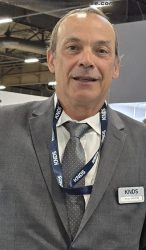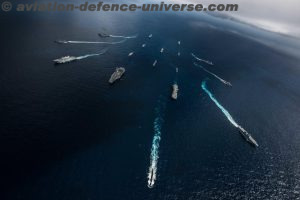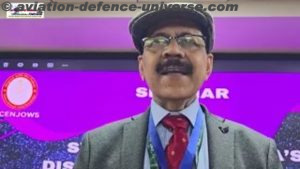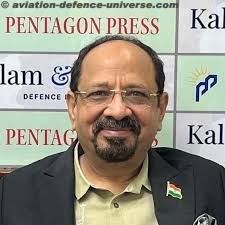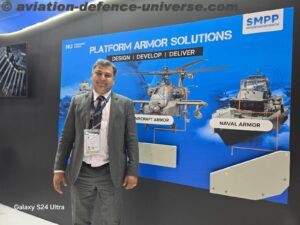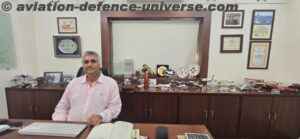By Sangeeta Saxena
Parc De Expositions, Paris. 05 November 2024. State-of-the-Art technologies ruled the roost at this year’s Euronaval and Europe took the cake at showcasing the latest and futuristic technologies for a global naval market. Swedish defence major Saab has launched the Autonomous Ocean Core, a cutting-edge control system designed to bring advanced autonomy to small and medium-sized naval platforms for both military and civilian missions. The system, which is vessel-agnostic, converts conventional craft into autonomous units, significantly enhancing mission effectiveness at sea. By entering the vessel’s parameters into its motion control function, operators can seamlessly enable uncrewed operations without compromising safety.
 Saab’s commitment to advancing unmanned systems is evident in the development of the Autonomous Ocean Core, which supports a wide range of naval missions. These uncrewed units are ideal for tasks demanding high endurance, involving significant risk, or requiring complex manoeuvres unsuitable for crewed vessels. Common operations include surveillance, intelligence gathering, communication, and logistics support, contributing to enhanced operational capabilities such as increased effect, intelligence, mobility, command, endurance, and protection. In the dynamic field of naval warfare, Saab’s Autonomous Ocean Core emerges as a crucial asset, elevating the capabilities of uncrewed systems to safeguard critical maritime interests and ensure the safety of open oceans.
Saab’s commitment to advancing unmanned systems is evident in the development of the Autonomous Ocean Core, which supports a wide range of naval missions. These uncrewed units are ideal for tasks demanding high endurance, involving significant risk, or requiring complex manoeuvres unsuitable for crewed vessels. Common operations include surveillance, intelligence gathering, communication, and logistics support, contributing to enhanced operational capabilities such as increased effect, intelligence, mobility, command, endurance, and protection. In the dynamic field of naval warfare, Saab’s Autonomous Ocean Core emerges as a crucial asset, elevating the capabilities of uncrewed systems to safeguard critical maritime interests and ensure the safety of open oceans.
At Euronaval 2024, an expert showcased the newly launched Autonomous Ocean Core—a groundbreaking control system designed to convert crewed vessels into fully autonomous platforms. In this exclusive interview with Peter Karlstrom, Saab’s Autonomous Ocean Core project manager, Aviation & Defence Universe (ADU) delves into the features of this technology, its real-time demonstration capabilities, and its potential applications for global navies, including India’s.
ADU. Congratulations on the launch of Autonomous Ocean Core. Can you tell us what this system is all about?
Peter Karlstrom. Thank you. Autonomous Ocean Core is a comprehensive control system designed to make vessels uncrewed and fully autonomous. It allows operators to directly control the vessel or engage autonomous functions, ensuring collision avoidance and smooth navigation. As a secure and adaptable foundation, Saab’s Autonomous Ocean Core is engineered to tackle the unique technical challenges of high-inertia, high-energy naval platforms. It ensures predictability and safety during critical operations such as departure, docking, navigating mission zones, and obstacle avoidance. Saab offers the system as either a standalone solution or as part of a comprehensive uncrewed system, with additional supporting technologies such as navigation systems, electronic warfare, remotely operated vehicles (ROVs), advanced radar systems, electro-optical (EO) sensors, and various effectors.
ADU. How does the control system work?
Peter Karlstrom. The system starts with direct controls like the steering wheel and throttle levers for manual operations. It also includes a joystick for vector control, enabling precise manoeuvres such as docking. This control setup allows the vessel to leave port, complete its mission, and return autonomously.
ADU. What role does the camera feed play in this system?
Peter Karlstrom. The camera feed is crucial for direct operation mode. It provides real-time visuals with low latency to ensure the operator sees up-to-date information. If the feed lags or loses bandwidth, the screen goes black to prevent the operator from relying on outdated images.
ADU. Can you explain the autonomous navigation feature?
Peter Karlstrom. Certainly. Once a mission point is set, the vessel autonomously calculates its route and adjusts it multiple times per second to avoid obstacles. The system includes a perception capability that identifies dynamic objects, such as other vessels, and adjusts its course accordingly.
ADU: What additional technologies are integrated into the platform?
Peter Karlstrom. For demonstration purposes, we have installed the SeaGiraffe 1X radar, a compact 3D radar for detecting both surface and aerial targets. We also showcased the system’s capability using a small DJI drone, which the radar can detect in real-time.
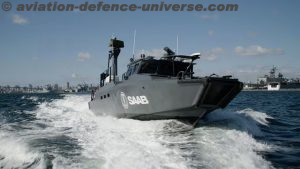
ADU. You mentioned a live demonstration from Paris. Can you elaborate on that?
Peter Karlstrom. Yes, we are controlling the vessel live from Paris, despite it being over 1,800 kilometres away in Sweden. This remote demonstration showcases the system’s reliability and effectiveness, allowing us to operate the vessel live at the expo.
ADU. Is the DJI drone integrated as part of the core system?
Peter Karlstrom. No, the DJI drone is used only for the expo to provide a visual demonstration. It’s not part of the core system but serves as a target for the radar, showcasing its detection capabilities.
ADU. How do you envision this system being useful for navies like India’s?
Peter Karlstrom. The solution Autonomous Ocean Core is built with an open architecture, offering a flexible and scalable for baseline vessel control on or below the ocean surface. It supports continuous integration of additional features, including third-party technologies, while maintaining built-in safety functions. The system is compatible with both new and retrofitted vessels, enabling plug-and-play payload integration and reducing the need for separate control and safety system developments. The system is vessel agnostic, meaning it can be installed on various platforms, from small to medium-sized vessels. Its open architecture allows customization with local interfaces and capabilities, making it highly adaptable for specific requirements of the Indian Navy or Coast Guard.
ADU. Can the Autonomous Ocean Core be tailored for seabed warfare?
Peter Karlstrom. Absolutely. Depending on the sensors installed, it can support seabed warfare operations. For instance, it can be equipped with a towed array sonar or an ROV (Remotely Operated Vehicle) for underwater exploration and scanning.
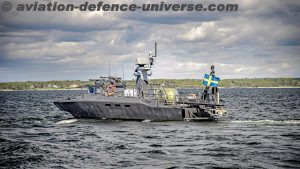
ADU. What is the advantage of using autonomy in naval operations?
Peter Karlstrom. Autonomous systems extend the capabilities of current naval assets, providing enhanced situational awareness and reducing the risk to human operators. They are especially valuable in hybrid warfare scenarios, where tasks like cable cutting or monitoring require advanced, unmanned solutions. Saab’s commitment to advancing unmanned systems is evident in the development of Autonomous Ocean Core, which supports a wide array of naval missions. These unmanned units are ideally suited for tasks that require exceptional endurance, involve high risks, or are too complex for crewed vessels. Typical operations include surveillance, intelligence gathering, communication, and logistics support, all of which contribute to enhanced operational capabilities such as increased effect, intelligence, mobility, command, endurance, and protection. In the evolving landscape of naval warfare, Saab’s Autonomous Ocean Core positions itself as a pivotal asset, advancing the capabilities of uncrewed systems to protect critical maritime interests and ensure safe, open oceans for all.
ADU. Any final thoughts on the potential impact of this technology?
Peter Karlstrom. The possibilities with Autonomous Ocean Core are immense. It opens up new avenues for naval operations by enhancing flexibility, adaptability, and safety. The system’s real-time control and autonomous features can significantly boost naval capabilities globally. The Autonomous Ocean Core is set to transform the landscape of naval operations, offering enhanced control and autonomy for various vessel types. With its flexible, vessel-agnostic design, the system promises to be a game-changer, particularly for navies like India’s that are seeking advanced, adaptable solutions for modern maritime challenges.
As Told to Sangeeta Saxena






































